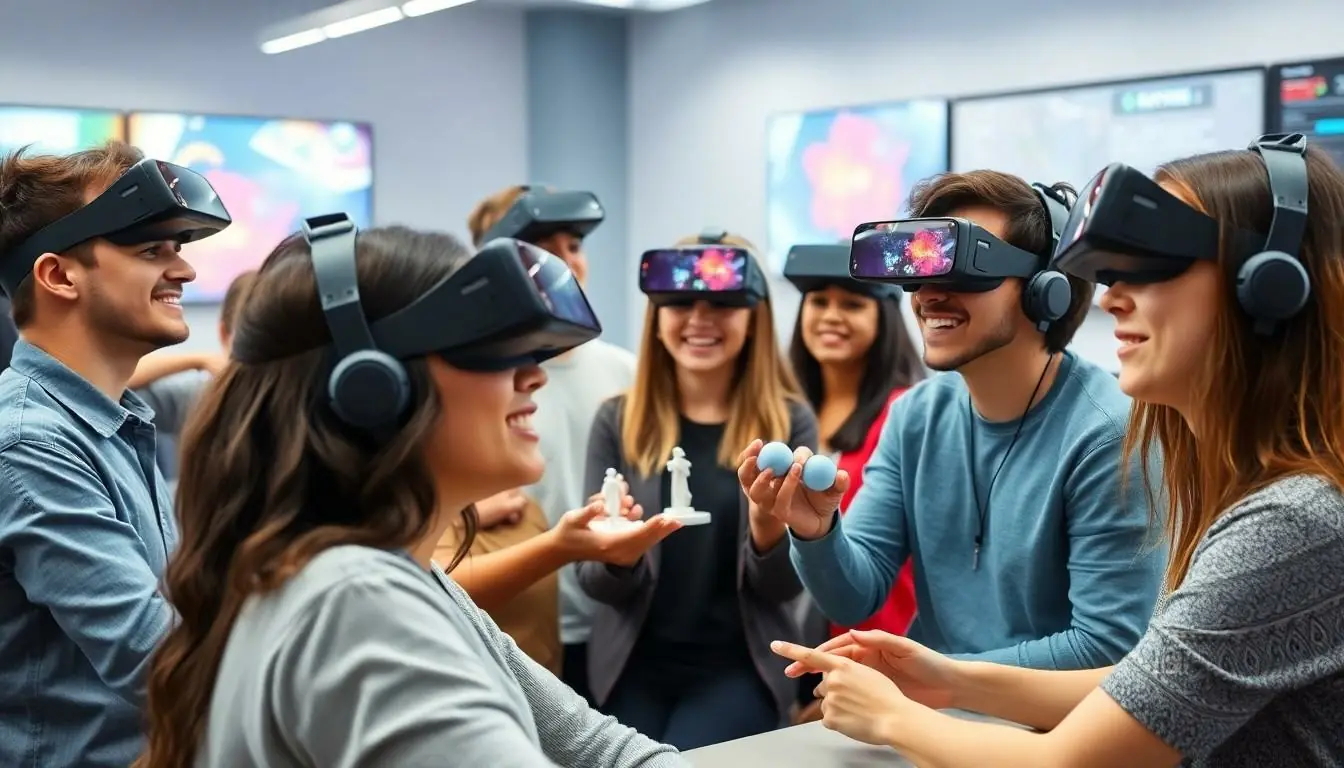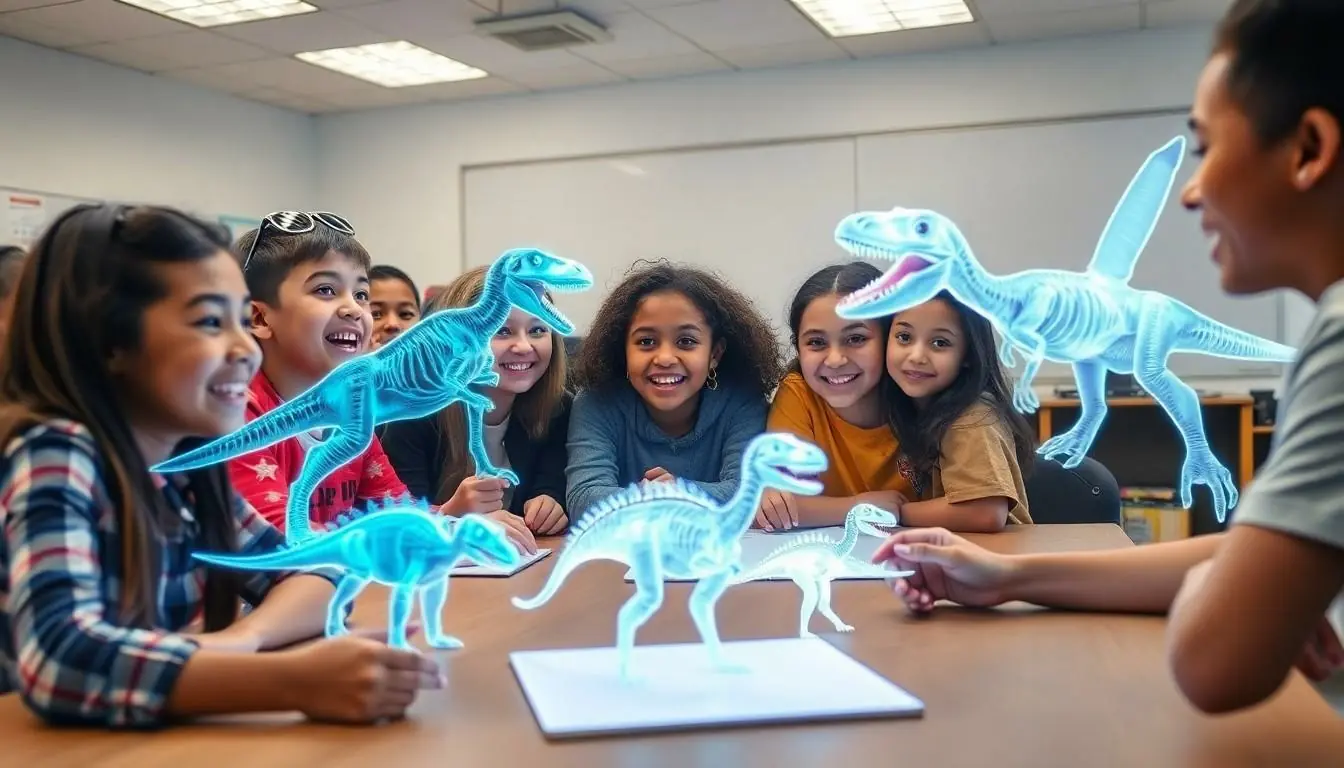Imagine walking into a classroom where textbooks are replaced by interactive holograms and history lessons come alive with virtual dinosaurs roaming the floor. Welcome to the world of AR education, where learning transforms into an adventure. This innovative approach not only captivates students’ imaginations but also enhances their understanding of complex subjects.
Table of Contents
ToggleOverview of AR Education
AR education enhances traditional learning methods through immersive experiences. It allows students to interact with 3D models and simulations, fostering deeper understanding of subjects. Subjects like science and mathematics become tangible as students visualize abstract concepts in real-world contexts.
Educational institutions increasingly adopt AR tools to enhance student engagement. Students can explore historical events by viewing them as interactive scenes, bridging the gap between past and present. Moreover, AR provides opportunities for collaborative learning, encouraging teamwork on projects that integrate technology.
Research supports the effectiveness of AR in education, showing increased retention rates among students who engage with interactive content. According to a study by the University of Washington, AR usage can increase test scores by up to 30%. This data emphasizes the significant advantages of incorporating AR in lesson plans.
Content accessibility improves through AR, as diverse learning styles meet innovative technology. Visual learners benefit from 3D representations while kinesthetic learners engage through interactive activities. Such approaches create inclusive environments that cater to various academic needs.
Skill development also features prominently in AR education. Students practice critical thinking and problem-solving in real-time scenarios, preparing them for future challenges. Industries recognize the importance of these skills, leading to the integration of AR in vocational training programs.
Adopting AR education presents both opportunities and challenges. Investing in technology and teacher training remains essential for successful implementation. Future developments in AR software and hardware promise to expand educational possibilities, making learning experiences even more dynamic.
Benefits of AR Education

AR education significantly transforms learning by enhancing engagement and improving retention. It creates an interactive environment that captivates students.
Enhanced Engagement
Engagement levels soar in AR learning environments. Students enjoy immersive experiences with 3D models and simulations that make complex subjects easier to grasp. Interactive historical scenes make events come alive, leading to better participation in lessons. Teachers report increased motivation, resulting in a more dynamic classroom atmosphere. Technology-driven projects encourage teamwork, allowing learners to collaborate while developing essential skills. Schools that adopt AR tools often see students more enthusiastic about their studies. High levels of interactivity also reduce distractions, helping students focus on the subject matter more effectively.
Improved Retention Rates
Retention rates improve when AR is integrated into education. Research indicates that AR can boost these rates and enhance test scores by nearly 30%. Engaging visuals and hands-on experiences help solidify knowledge, making it easier to recall information later. Real-world applications of concepts foster deeper understanding, increasing students’ ability to connect new information to prior knowledge. Active participation through simulations allows learners to practice skills in a risk-free environment, reinforcing learning outcomes. AR education not only aids in memorization but also emphasizes critical thinking, leading to long-term knowledge retention.
Challenges in Implementing AR Education
Implementing augmented reality in education brings several challenges. These challenges require careful consideration for successful integration.
Technological Barriers
Technological limitations hinder widespread AR adoption in educational settings. Schools may lack sufficient hardware, such as tablets or AR glasses. Software compatibility issues can also arise, making it difficult for educators to utilize AR applications seamlessly. Additionally, inadequate internet connectivity restricts access to online resources and updates. Many teachers lack training in using AR tools effectively, which can lead to underutilization. A reported 40% of educators indicate a need for professional development in AR technology. Overcoming these barriers is essential to ensuring smooth implementation.
Cost Considerations
Cost remains a significant hurdle in deploying AR education. Initial investment in AR equipment and software can be substantial. According to recent studies, implementing AR technology in schools can reach up to $100,000 for a fully integrated system. Ongoing maintenance and upgrades also contribute to long-term expenses, making budget allocations critical. Schools with limited resources may prioritize traditional teaching methods over AR innovations. Seeking funding or grants dedicated to technology in education can help mitigate these financial burdens. Balancing costs against potential benefits complicates decision-making in educational institutions.
Successful AR Education Case Studies
One prominent case study comes from the University of Illinois, where augmented reality significantly transformed medical training. Students utilized AR to visualize human anatomy, allowing them to explore 3D representations of organs in situ. The interactive experience led to a 25% increase in comprehension and practical skills among participants.
Another noteworthy example is the use of AR in language acquisition at the University of South Florida. Language students interacted with virtual environments, practicing real-life conversations with 3D avatars. Feedback indicated that student retention rates improved by 30%, demonstrating the effectiveness of immersive learning.
In K-12 education, AR has gained traction at the Franklin Academy in North Carolina. Teachers incorporated AR applications into science lessons, enabling students to conduct virtual experiments. Observations noted that students displayed heightened enthusiasm and curiosity, resulting in improved test scores and increased class participation.
Moreover, a pilot program in Singapore showcased AR’s potential in history education. Students engaged with historical events through augmented reality timelines. This approach enhanced their understanding of context and chronology, leading to a documented 20% rise in retention compared to traditional methods.
The potential for AR in education is evident in these case studies. Each institution adopted innovative technologies, resulting in enhanced engagement, improved retention, and overall better learning outcomes. These examples underscore the value of integrating AR into educational practices.
Future Trends in AR Education
Emerging technologies are set to transform AR education significantly. Continued advancements in hardware and software will improve the accessibility and effectiveness of AR tools in classrooms. Enhanced mobile AR applications allow for learning on-the-go, making education more flexible.
Incorporation of artificial intelligence into AR platforms can provide personalized learning experiences tailored to individual student needs. Virtual reality integration with AR could create immersive environments, further deepening engagement and understanding.
Accessibility features will expand, ensuring all students, including those with disabilities, benefit from AR education. Collaborative lesson plans using AR are anticipated to foster teamwork among students, enhancing social skills and communication.
Adoption of AR content creation tools will enable teachers to design customized learning experiences. Educational institutions are increasingly looking at partnerships with technology firms to develop specialized AR solutions relevant to their curricula.
Data analytics will play a crucial role in AR education, tracking student progress and engagement levels. This information can inform teachers on how to adjust their teaching methods for better outcomes.
Sustainability in AR technology development is becoming a priority, focusing on eco-friendly materials and energy-efficient devices.
Global collaboration on AR educational tools will likely grow, with schools from different countries sharing resources and innovations.
As AR education evolves, it remains crucial for institutions to invest in teacher training programs, ensuring educators leverage these tools effectively.
AR education represents a significant leap forward in how students engage with learning. By transforming traditional classrooms into interactive environments, it fosters deeper understanding and retention of complex subjects. The positive outcomes seen in various educational settings highlight AR’s potential to revolutionize the learning experience.
While challenges remain in terms of technology access and funding, the ongoing advancements in AR tools promise to enhance educational practices further. As schools continue to explore innovative solutions, the future of AR education looks bright, paving the way for more engaging and effective learning experiences for all students. Embracing these changes is essential for educators aiming to prepare learners for a rapidly evolving world.

